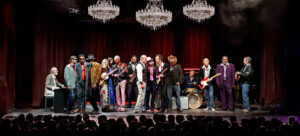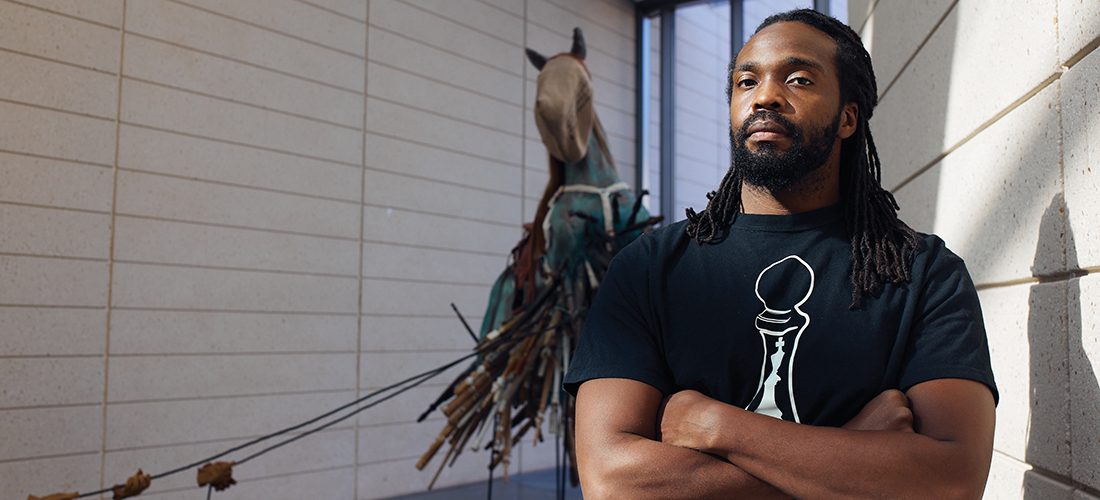
Stephen Hayes and the African American experience
By Jim Moriarty
Photo: Stephen Hayes in front of his sculpture Flying W by Samantha Everette
We’re sitting in a mostly empty museum gallery, face to face, almost kneecap to kneecap. He has his mask on. I have my mask on. His words echo off the walls and high ceiling, but not with the plain thunder of his work surrounding us.
To my right, his left, is Cash Crop! He made it 12 years ago on his way to his Master of Fine Arts from the Savannah College of Art and Design in Atlanta. It’s wood and cement and steel. Fifteen naked figures, pockmarked, burnt in places, arranged in a triangle, standing against 15 wooden pallets. On the back of the pallets is the drawing of the infamous Brookes slave ship plan, its cruelty accentuated by its simplicity, a barbaric commoditization of kidnapped humans laid end to end, elbow to elbow, head to toe, row by row, to endure the inhumanity of the middle passage. The figures — casts of friends, family, even one of himself — are linked together by rusted steel chain all gathering at a square wooden block.
“It took me five months to create everything, start to finish. I did all the castings, the blacksmithing, the forging. Did all the carvings,” Stephen Hayes says of Cash Crop! “Five months, day and night, not thinking about anything but making.” He calls it his “machine mode.” The figures are upright so you can look them in the eye, then walk around and imagine them as a mark on a diagram, an entry in a ledger, given barely enough room to survive, sometimes not even that. Walking between the figures “you might hit a chain,” says Hayes. “Always stumbling over the past.”
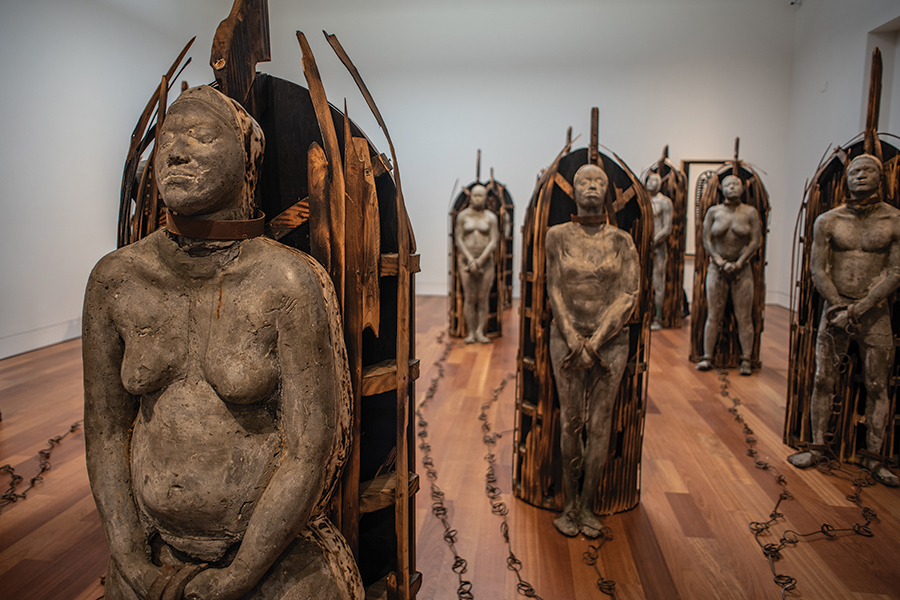
Two weeks after he first showed Cash Crop! in Atlanta, Hayes was interviewed by CNN. “I didn’t know the weight of what I had created. I had an apartment but I didn’t have heat. I had electricity but I didn’t have cable. I couldn’t watch it,” says Hayes. He went to an AT&T store to see himself on the news.
Making sculpture is a pricey endeavor for a student, even a gifted one. “I knew how to penny-pinch,” he says. “My mom helped me out with money here and there.” Hayes grew up in Durham, where his mother, Lender, worked at the Durham County Department of Social Services on Duke Street. At night she cleaned the building as a second job. “She was everything,” he says.
You might think that the line from CNN to a commercially successful career as an artist would be a more or less straight one, but you would be wrong. Hayes knew how to create, but he didn’t know how to market. When he was an undergrad student at North Carolina Central University, one of his teachers, Isabel Chicquor, went to his house, took photos of all his ceramic work, built him a portfolio and got him his first residency at Alfred University in upstate New York. He knew art — though he didn’t call it that — he just didn’t know how to navigate the system. When someone suggested he apply to SCAD, he “stayed on the porch of my house and built a bunch of stuff and took photos of it.” To his own surprise, he was accepted, left New York and went to Atlanta. That got him on TV but it didn’t get him a living.
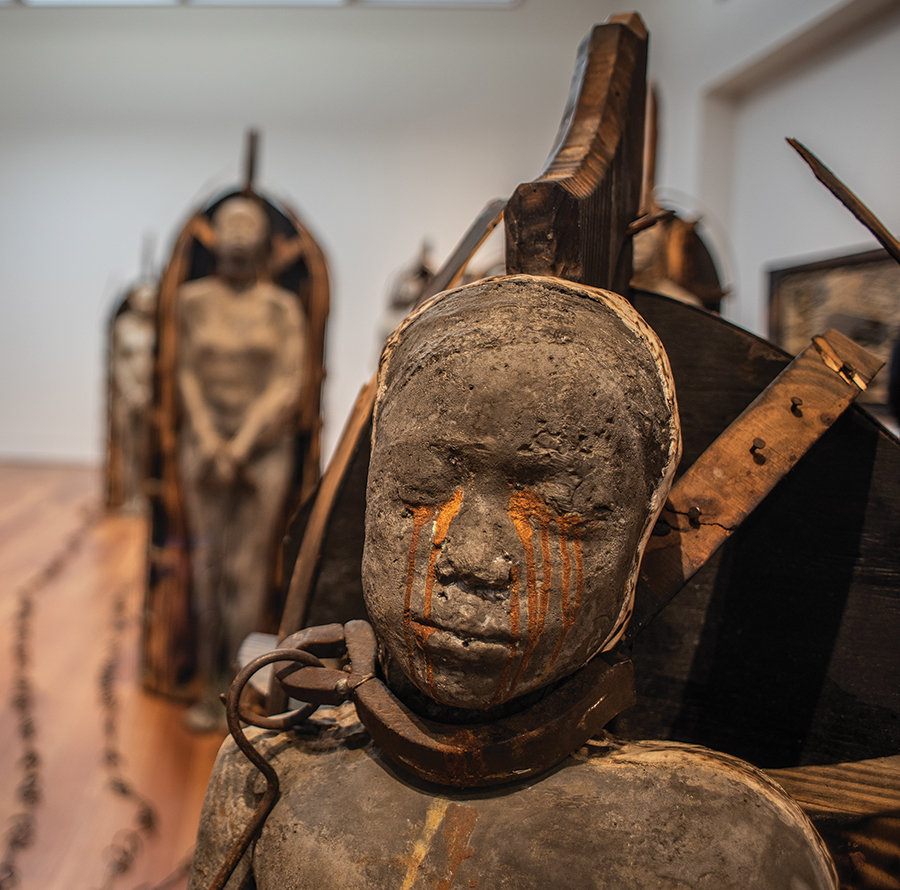
While Cash Crop! spent the next decade-plus touring museums from Montgomery, Alabama, to Philadelphia, Pennsylvania, Hayes got teaching gigs here and there. He returned to Durham and, at one point, worked in a shipping container yard. He was on the precipice of giving up on the business of art altogether the night he got a residency at the Halcyon Arts Lab in Washington, D.C., leading indirectly to another highly acclaimed work, Voices of Future’s Past, exhibited at the National Cathedral and currently on view at the North Carolina Museum of Art along with another of his works, 5 lbs. In Voices, Hayes recorded young Black men talking about their lives, their feelings, their experiences, and placed their words inside the busts of older African American men. “When you walk by you have to get up close and kind of lean in to hear what the kid inside him is saying,” says Hayes.
After D.C., Hayes, who now teaches at Duke University, was named the 2020 recipient of the 1858 Prize for Contemporary Southern Art.
The exhibition hall where we’re sitting is in the Cameron Art Museum in Wilmington, where Hayes has a one-man show closing March 20. The exhibition of his work coincided with the unveiling of Boundless, his sculpture honoring the United States Colored Troops who fought in the Battle of Forks Road. The remnants of the old road and the vestiges of eroding Confederate revetments are a few yards from the museum’s parking lot. On that day, a section of the sculpture was being reinstalled after it was removed to add a plaque engraved with the names of 1,820 Black soldiers who fought there. Since 2006, the Cameron has hosted a re-enactment of the battle that took place on its property on Feb. 20-21, 1865, when a brigade of over 2,000 USCT soldiers assaulted well-entrenched Confederate infantry and artillery through a narrow gap between swampy Carolina bays. Re-enactors representing the Ohio 5th, a USCT regiment that included two recipients of the Medal of Honor and was known to have fought in the 34-hour engagement, are annual participants.
In his book Glory at Wilmington, The Battle of Forks Road, historian Chris E. Fonvielle Jr. writes, “The headlong assault by the bravest of the brave African American soldiers and their comrades at Forks Road was a ‘brilliant little charge,’ reported one journalist. But the concentrated Confederate rifle-musket and light artillery fire along the narrow front doomed the attack . . . The 5th U.S. Colored Troops at the head of the attacking column, suffered far more casualties than any other unit. The regiment’s 39 dead and wounded soldiers accounted for 74 percent of the total Union losses in the battle.”
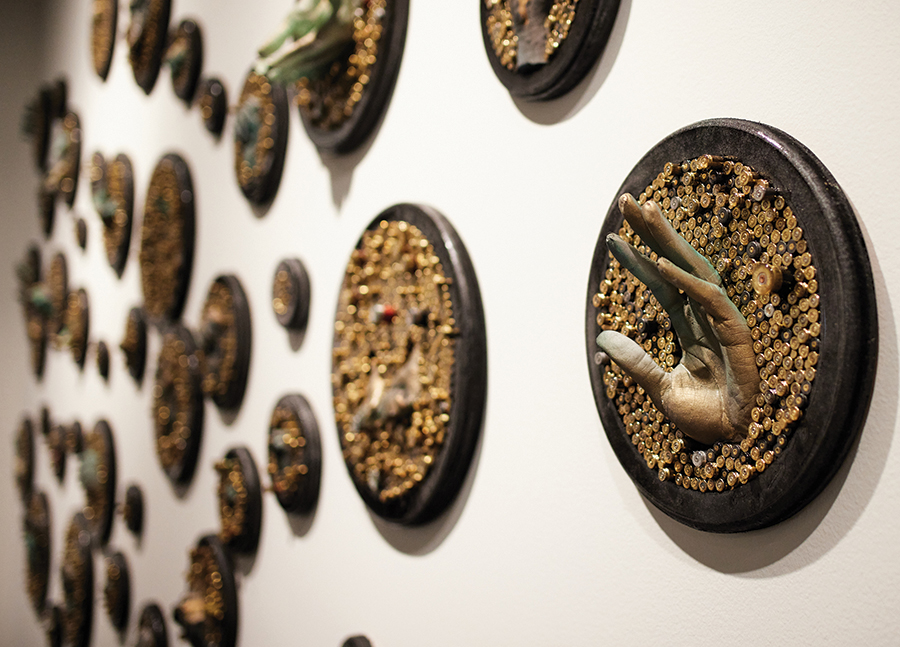
In 2019, after the museum’s deputy director, Heather Wilson, successfully wrote a grant securing funding for the sculpture, the Cameron commissioned Hayes to create Boundless. The museum’s executive director, Anne Brennan, invited him to attend the re-enactment of the battle that February. “He was captivated by imagining the sound of their marching boots,” says Brennan of Hayes. “He’s hearing their boots coming up the road. They’re chanting. He’s a brilliant sculptor but it was the dimensionality of sound that first struck Stephen. Those boots. Those boots.”
The DNA of Boundless stretches in two directions, toward Cash Crop! inside the museum and toward Augustus Saint-Gaudens’ 19th century sculpture of Robert Gould Shaw and the Massachusetts 54th on the Boston Common, 800 miles away. The story of the 54th was most recently retold in the 1989 movie Glory.
“We took away the commanding general. Took away that beautiful horse and focused on the infantry,” says Brennan. “There had to be ranks marching. The drummer and the color bearer advancing in full three dimensions activates the work. It’s an homage. It’s an inspiration. Stephen brings that contemporaneity to it.”
For Boundless, Hayes did castings of the faces of seven USCT descendants and four USCT re-enactors for the 11 figures — a color bearer, a drummer and nine soldiers joined together in rows of three. “They’re moving forward. They’re in motion,” says Hayes. “Boundless is on the ground these soldiers actually marched on. I wanted it to be on the ground so people could walk through it and experience it — not be on a pedestal. They weren’t on horseback or anything. How did their footsteps sound? What did they sing? What’s going on in this man’s head?”
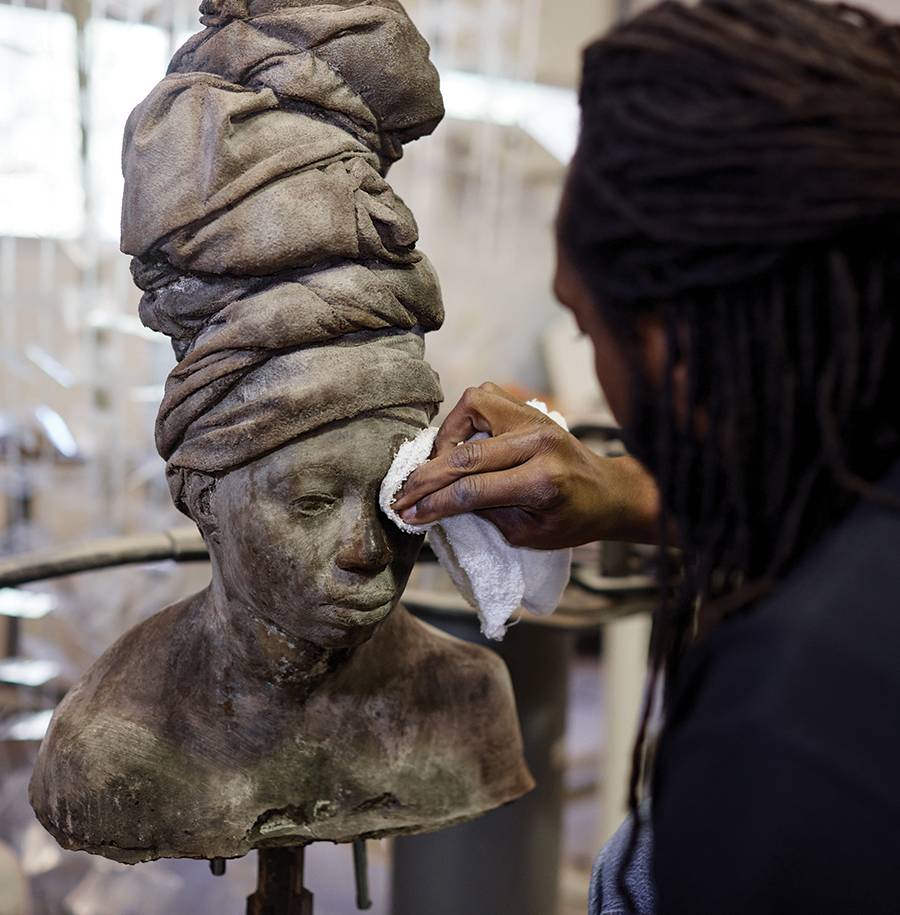
Hayes’ sculpture has more contemporary artistic roots than Saint-Gaudens, linking to the tradition of Black sculpture of the 1960s and ’70s and, in particular, to the work of William Ellisworth Artis, who was born in Washington, North Carolina. “Hayes is following that tradition of humanizing the Black experience and really bringing it out in this figurative way,” says Maya Brooks, the Mellon Foundation assistant curator at the North Carolina Museum of Art. “He’s using symbols from across African American history to really think about the themes that he wants to present in terms of how an identity is created, how an identity is formed within a community.”
Hayes says, “Everything I’ve done is thematically joined. Cash Crop! is talking about the transporting of people, but if you take the roof off you can look at it like a sweat shop in a third world country with just enough room to produce as much goods as possible to ship to America. Boundless talks about freeing people of being slaves and talks about how we’re still fighting for that kind of freedom.” Fighting for the freedom proffered by the slave owner who wrote “We hold these truths to be self-evident, that all men are created equal …”
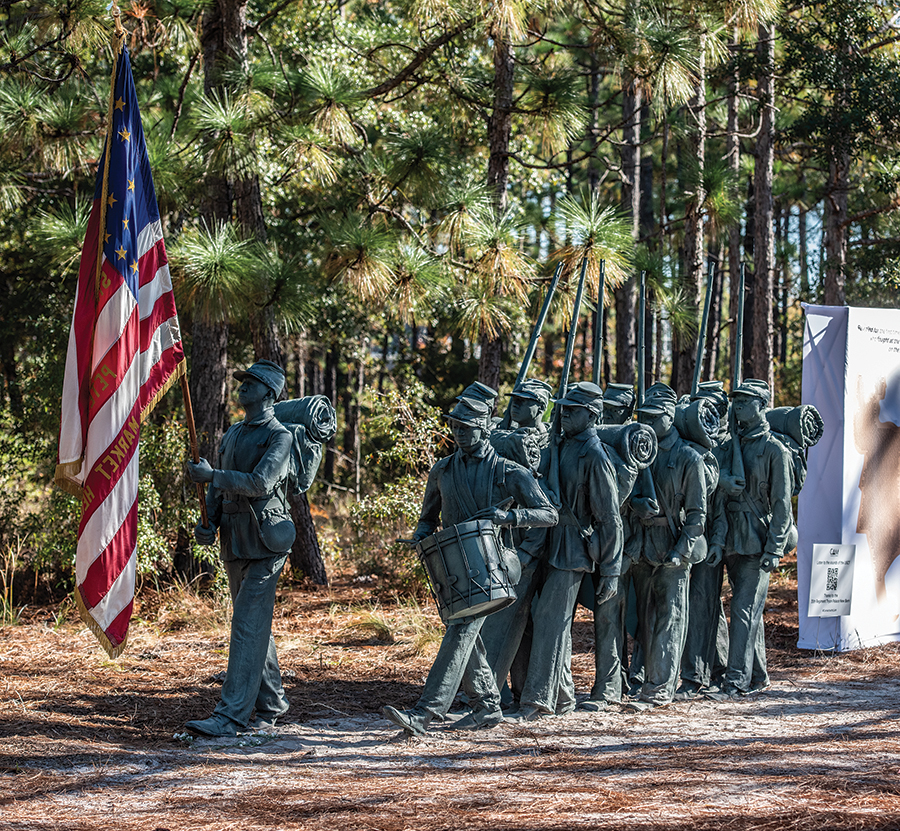
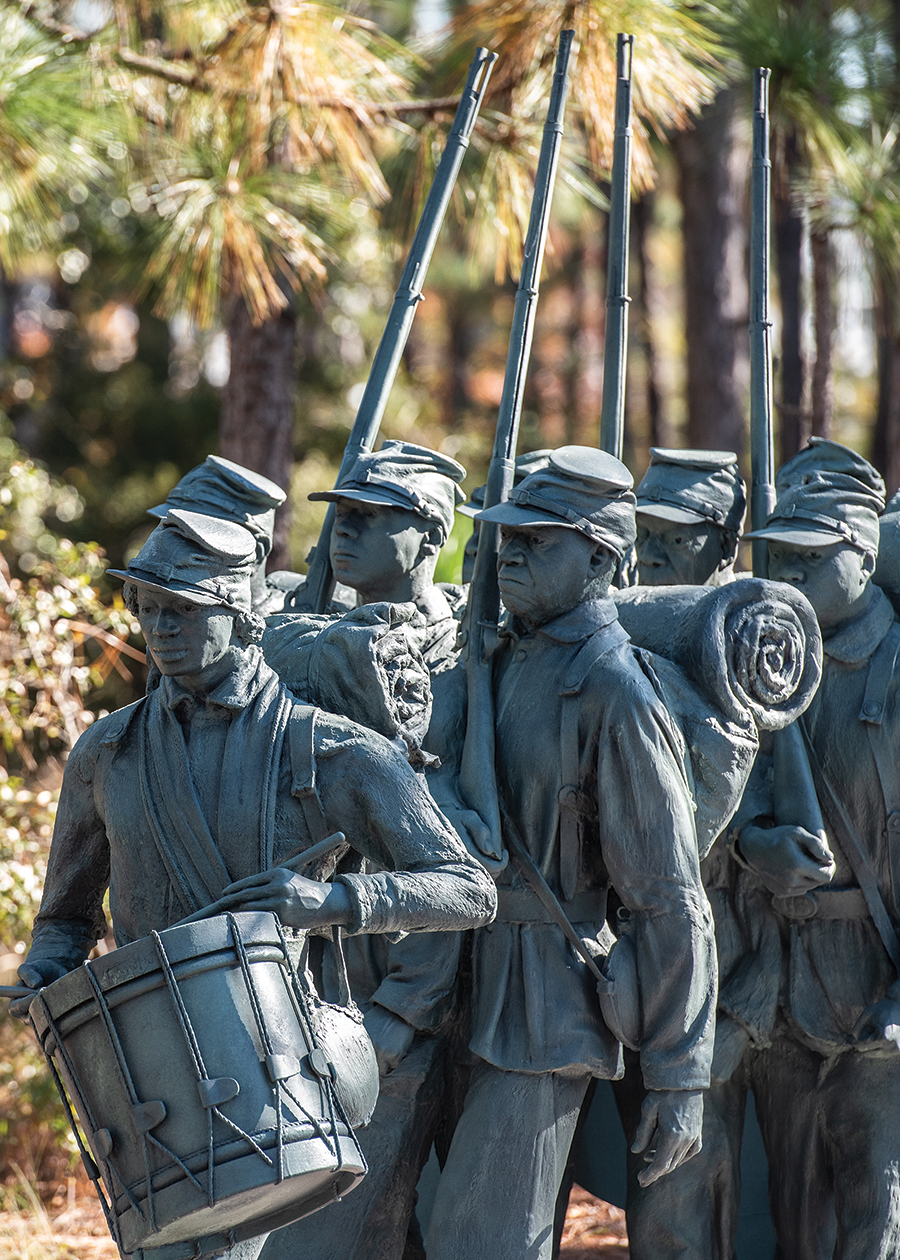
The day after the Battle of Forks Road, the Confederate Army abandoned Wilmington, its last link to supplies from the outside world, and the Union troops marched into the city. “Come daybreak these men bury their dead and advance 3 miles to city hall,” says Brennan. “The USCT was on the front lines for Forks Road and then, come the victory march, they are in the back of the parade.”
Hayes’ next big commission is in Charleston, South Carolina, where he’ll help create a memorial for 36 bodies of the poor and enslaved found in a mass grave nine years ago. “Every project holds a place in my heart,” he says. “I’m still pushing along, trying to make a name for myself. I’ve got to move on to the next thing.”
Stumbling over the past, in machine mode. PS
Jim Moriarty is the Editor of PineStraw and can be reached at jjmpinestraw@gmail.com.




